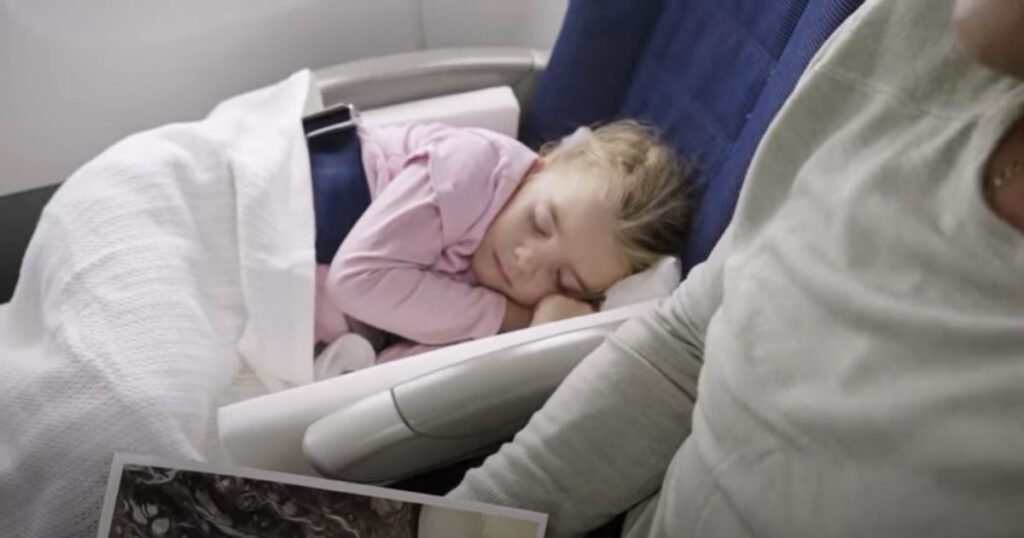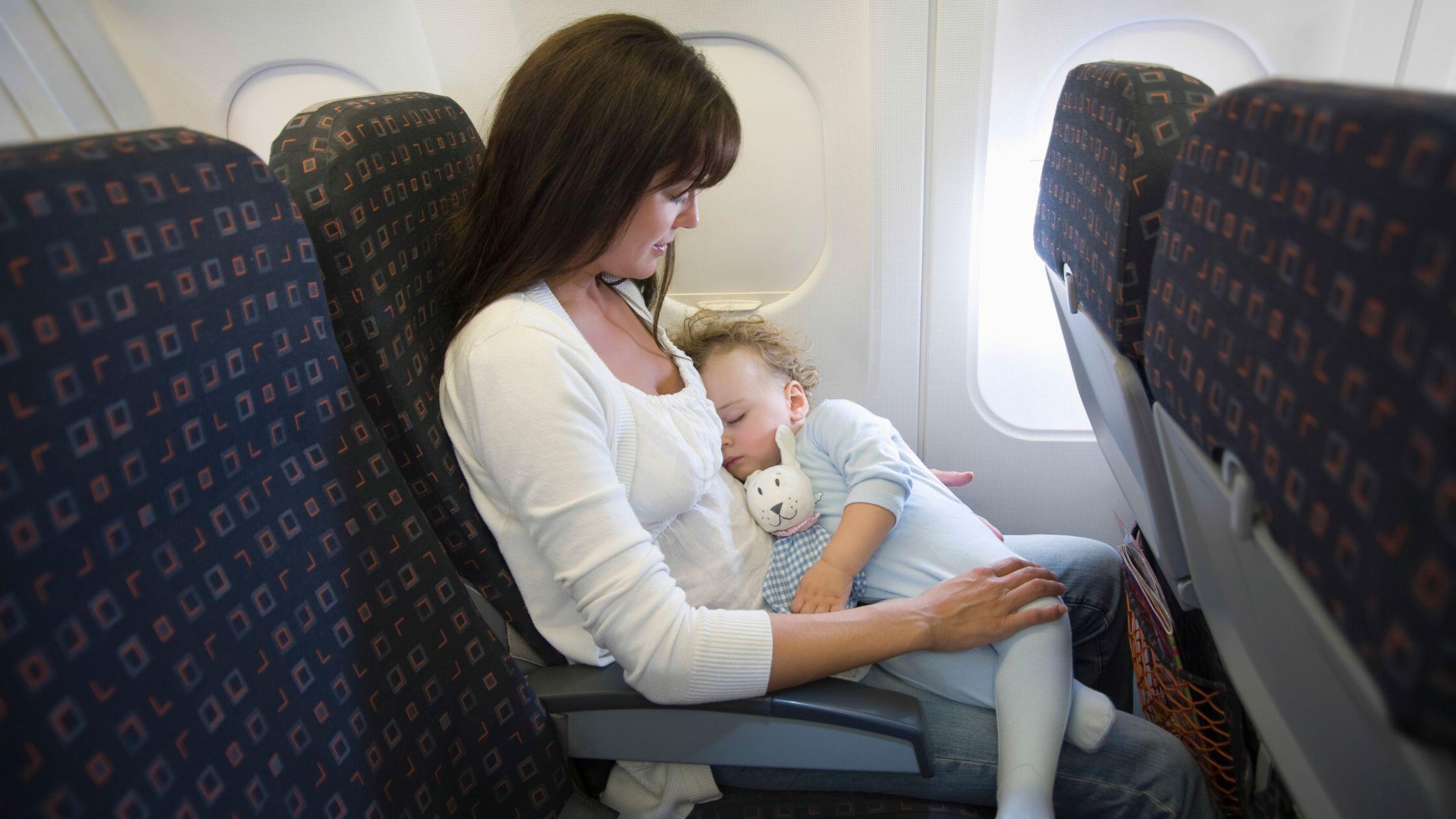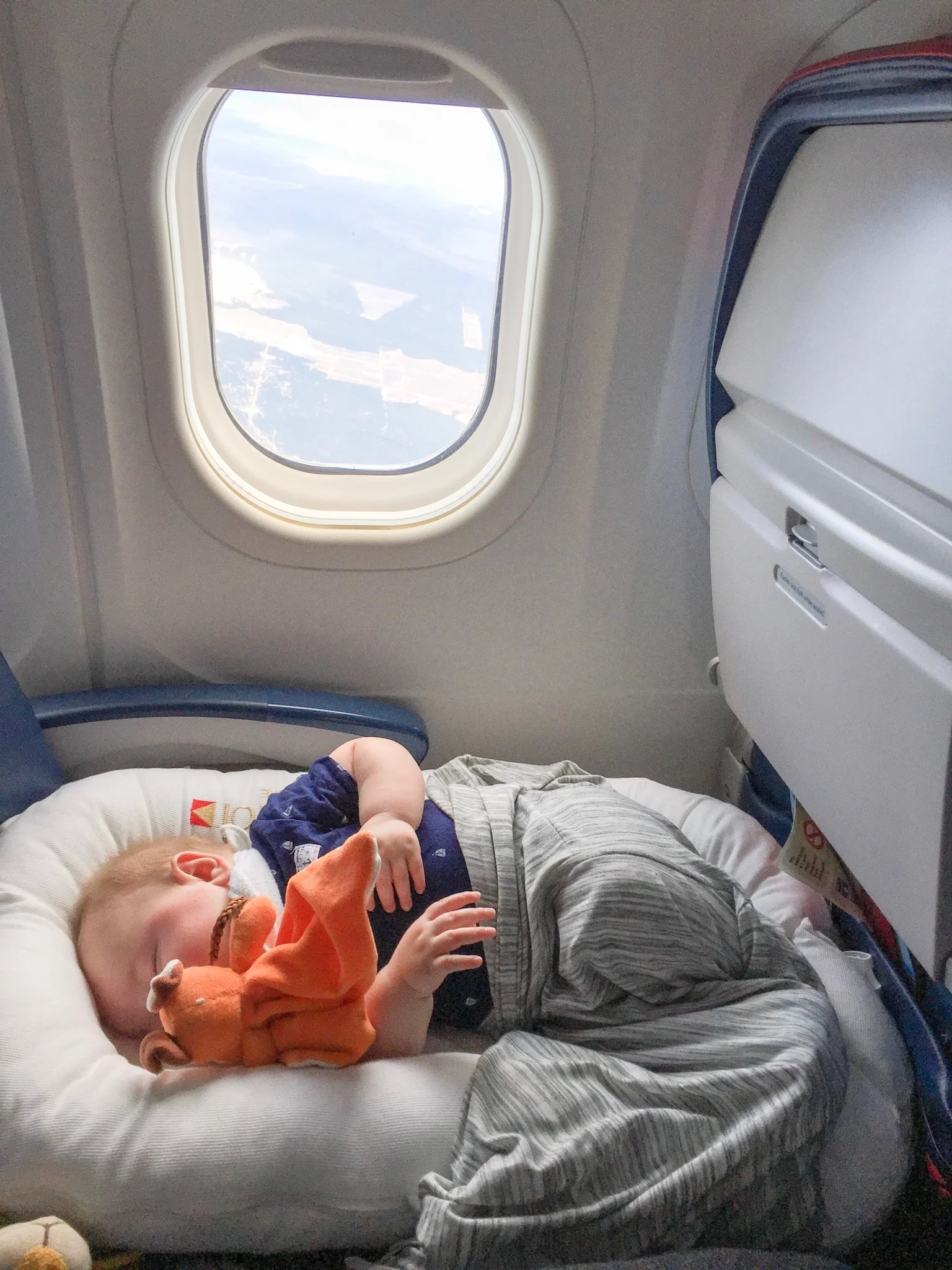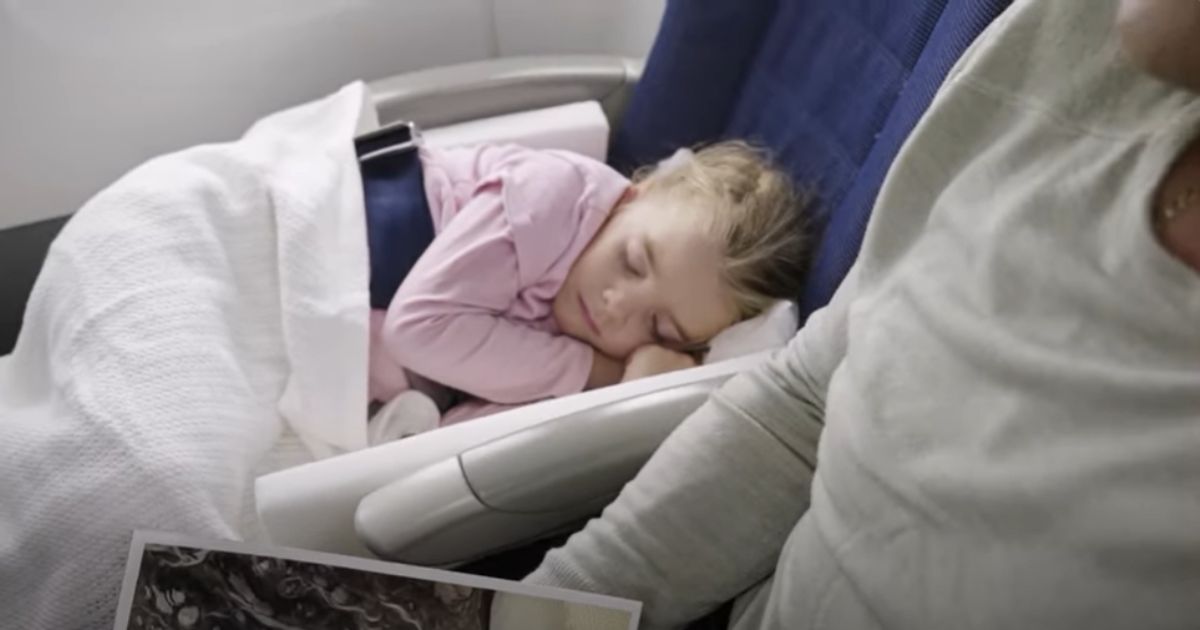As an Amazon Associate, I earn from qualifying purchases
Baby to Sleep on a Plane: It is going to be hard for babies to pull off a full-length nap on a plane, but your best bet is to try to keep as much of their regular sleep routine during the day as possible (with a good nap preceding flight time) and make sure you have some favorite items from home in which he/she associates sleep with packed in a separate small bag.
If you thought it was tough only putting your baby to sleep in its crib wait until you try doing that on a plane. Though, with a little forethought and some simple tips it is possible to have your baby sleep soundly while you are up in the air.
In this post, I am sharing ways to get your baby to sleep on the plane so you arrive at your destination feeling rested and ready for your vacation!

Best Time to Schedule a Flight
The best time to schedule a flight with a baby is around their natural sleep schedule. For longer trips, booking a red-eye or night flight is ideal, as the darkness and quieter cabin environment can encourage your baby to fall asleep more easily.
For shorter flights, try to match the flight time with your baby’s usual nap time. This way, your little one is more likely to be tired and ready to sleep during the flight, making the experience smoother for both of you.
Preparing For The Flight
Create a soothing environment with familiar items, maintain a consistent routine, and consider using white noise to promote relaxation during the flight. Remember to pack essential sleep aids and be prepared to adapt to your baby’s needs.
Book A Flight During Baby’s Sleep Time
One of the most effective ways to help your baby sleep on a plane is by scheduling your flight during their regular sleep time. Whether it’s a nap or bedtime, aligning your travel with their natural sleep schedule increases the chances of them dozing off during the flight.
Get Baby’s Bassinet On Board
Many airlines offer bassinets for infants, providing a safe and comfortable space for your baby to sleep. Be sure to request one in advance, as availability is limited and often on a first-come, first-served basis. A bassinet not only helps your baby sleep more comfortably but also gives you some hands-free time to relax during the flight.
Pack Baby’s Sleep Essentials
Ensure to pack baby’s favorite blanket, pacifier, and comforting toys to help them feel secure and fall asleep easily.
When traveling with your baby, it’s crucial to make necessary preparations to ensure a smooth journey. Here are some tips to help you get your baby to sleep on the plane:
– Book a flight during baby’s sleep time – Get baby’s bassinet on board – Pack baby’s sleep essentials By following these steps, you can increase the likelihood of your baby sleeping peacefully during the flight.
Feeding And Sleeping Schedule
When it comes to traveling with your baby, sticking to their regular feeding and sleeping schedule can make a world of difference in ensuring a smooth journey.
Adjusting to a new time zone while on a plane can be challenging, but with careful planning, you can help your baby maintain their routine and minimize disruptions to their sleep and feeding patterns.
Stick To Baby’s Regular Feeding Schedule
Plan your flight around your baby’s regular feeding times to ensure they are well-fed and comfortable. Bring along pre-measured formula or breast milk in travel-friendly containers to make feeding on the plane a breeze.
- Offer your baby a bottle or breastfeed during takeoff and landing to help with ear pressure changes.
- Pack extra snacks or milk in case of delays or hunger strikes during the flight.
Adjust Baby’s Sleep Schedule To The New Time Zone
Adapting your baby’s sleep schedule to the new time zone can help reduce jet lag and make the transition smoother. If possible, start adjusting your baby’s sleep routine a few days before the trip to align with the new time zone.
On the plane, encourage naps during the usual sleep times to help your baby adjust to the new schedule.
Create a comfortable sleep environment on the plane by bringing along familiar sleep aids such as a favorite blanket or stuffed animal.
Establish a bedtime routine, even while traveling, to signal to your baby that it’s time to sleep.
Plan For Feeding And Sleeping On The Plane
Planning for feeding and sleeping on the plane can help you manage your baby’s needs effectively. Consider the logistics of feeding and changing your baby while in the air, and be prepared with the necessary supplies in your carry-on bag.
| Feeding | Sleeping |
|---|---|
| Pack enough formula, breast milk, or baby food for the duration of the flight. | Bring a lightweight, portable bassinet or travel crib if the airline allows. |
| Use disposable bibs and utensils to simplify feeding and minimize mess. | Dress your baby in comfortable, breathable clothing suitable for sleeping in varying cabin temperatures. |
Getting Baby Comfortable On The Plane
Ensuring your baby is comfortable during a flight can make a huge difference in how well they sleep. Here are some strategies to help you create a sleep-inducing environment and dress your baby in comfortable clothes for a peaceful journey.
Choose The Best Seat For Baby
When booking your seats, look for options that provide extra legroom or bassinet for your baby to sleep in. Consider selecting a seat in a quieter area of the plane to minimize disturbances.
Create A Sleep-inducing Environment
- Dim the lights and use a travel blackout blind to block out any external light that could disrupt your baby’s sleep.
- Use a white noise machine or soothing music to drown out any background noise on the plane.
- Bring familiar items from home, such as a favorite blanket or stuffed animal, to provide comfort and familiarity.
Dress Baby In Comfortable Clothes
When dressing your baby for the flight, opt for soft, breathable fabrics that won’t irritate their skin. Ensure they are dressed in layers so you can easily adjust their clothing to suit the temperature on the plane.
Entertaining Baby On The Plane
When it comes to entertaining your baby on a plane, it’s essential to be prepared with activities that will keep them engaged and happy throughout the journey.
Here are some tips to help you keep your little one entertained:
Bring Baby’s Favorite Toys And Books
- Pack a variety of toys that your baby loves to play with, such as rattles, soft toys, or teething rings.
- Include some interactive books with bright colors and textures to capture your baby’s attention.
Download Baby-friendly Apps And Videos
- Download age-appropriate apps and videos on your device before the flight to entertain your baby.
- Choose educational apps or soothing videos that can keep your baby engaged and calm during the journey.
Engage Baby In-Play
- Play interactive games with your baby, such as peek-a-boo or singing nursery rhymes, to keep them entertained.
- Bring along small toys that encourage motor skills development, like stacking cups or shape sorters.
Dealing With Ear Pressure
Ease your baby’s ear pressure during flights with simple techniques. Encourage sleep by feeding, rocking, or using a comfort object. Consider timing flights during nap time for a peaceful journey.
Feed Baby During Takeoff And Landing
The sucking motion during breastfeeding, bottle-feeding, or using a pacifier helps equalize pressure in their ears, preventing pain that could disrupt their sleep. Timing feeds during these critical moments will not only keep your baby comfortable but also help them relax and settle down for a nap more easily.
Use Earplugs Or Noise-cancelling Headphones
Airplane noise can be disruptive for babies trying to sleep. Using earplugs or baby-friendly noise-canceling headphones can help minimize the impact of the loud engine sounds and background chatter. These tools create a quieter environment, allowing your baby to rest more peacefully during the flight.
Try Other Ear Pressure Relief Methods
There are other ways to relieve your baby’s ear pressure. Offering a pacifier, encouraging them to suck on a bottle, or using a teether can help. For older babies, you can try gentle ear massages or yawning to ease the discomfort. These simple methods can prevent ear pain, making it easier for your baby to stay calm and fall asleep during the flight.

Managing Baby’s Anxiety And Discomfort
Babies can feel anxious and uncomfortable during flights, which can make it challenging for them to sleep. Fortunately, there are several strategies you can employ to help ease your baby’s anxiety and discomfort, making the journey more pleasant for both you and your little one.
Use Pacifiers Or Bottles During Pressure Changes
During takeoff and landing, changes in air pressure can cause discomfort for babies. Encourage your baby to suck on a pacifier or bottle during these times to help equalize the pressure in their ears, providing relief and reducing their anxiety.
Give Baby A Massage To Ease Tension
Gentle massages can work wonders in relaxing a baby’s tense muscles and soothing their nerves. Prior to the flight, take a few moments to gently massage your baby’s back, arms, and legs, using light, rhythmic strokes to help them relax and feel more comfortable during the journey.
Offer Baby A Comfort Item
Bringing along a familiar comfort item can provide your baby with a sense of security and reassurance. Whether it’s a favorite blanket, stuffed animal, or soft toy, having something familiar nearby can help your baby feel more at ease in an unfamiliar environment, promoting better sleep during the flight.
Interacting With Other Passengers
When traveling with a baby, it’s essential to consider the impact your little one may have on fellow passengers. Interacting with other passengers in a respectful and considerate manner can make a significant difference in how your journey unfolds.
Be Courteous And Considerate
Being polite and considerate goes a long way in creating a positive environment for everyone on the plane. Remember, everyone has their own travel experience, and showing respect can help alleviate any potential tension.
Communicate With Nearby Passengers
A simple greeting and a polite acknowledgment of your baby’s presence can help break the ice with neighboring passengers. It’s helpful to establish an open line of communication from the start.
Offer Apologies And Gratitude
If your baby becomes fussy or unsettled, don’t hesitate to apologize to those around you. Expressing gratitude for their patience and understanding can help foster a sense of empathy and goodwill among fellow travelers.
Dealing With Unexpected Situations
When traveling with your baby, unexpected situations can arise, but with proper preparation, you can handle them effectively.
Prepare For Flight Delays Or Cancellations
- Check with the airline for any updates on the flight status to anticipate delays or cancellations.
- Pack extra essentials like diapers, formula, and snacks in case of prolonged waiting times.
Handle Baby’s Sickness Or Discomfort
- Carry a first aid kit with baby-friendly medications for common illnesses or discomfort.
- Comfort your baby with soothing techniques like gentle rocking or singing to alleviate any discomfort.
Be Ready For Emergencies
- Know the location of emergency exits and safety equipment onboard the plane.
- Keep important contacts such as your pediatrician or emergency services handy in case of urgent situations.
Post-flight Tips
How to get your baby to sleep on the plane Try to bring familiar sleep objects — blankets, favorite cuddly things. Even flying at preferred times—like during your baby’s nap time—could make you more likely to be seated 50 rows away from your hydration station.
Post-Flight Hacks: While getting to your destination with a baby can be tough, it is just one part of the struggle. The post-flight period too requires a bit of prep and managing to help your baby bounce back after the sojourn.
Tips to Help You and Your Baby Recover from a Flight and Make the Most of Your Trip H3: Stick to Baby Sleep Schedule (at home) Sticking to your baby’s sleep schedule is essential, especially if you already traveled to different time zones. When possible, feed your baby at the regular times and put her to bed at bedtime.
For infants who have difficulty falling asleep, feel free to use common sleep cues like a favorite blanket or white noise machine. They serve as a few comforting items to urge the baby back into relaxation and sleep mode.
H3: Jet Lag Jet lag can be a nightmare if you are traveling with an infant. The more natural, bright light during the day that your baby gets (even days after birth), and the darker the room at night or consistent darkness, will help correct her/her day-night confusion. This could help establish the internal clock of your baby according to the new time zone. Also, try not to over-stimulate your baby right before bedtime.
Try relaxation exercises like reading or taking a bath before falling asleep. As a result, these activities help to relax your baby which makes this easier for him/her to sleep.
H3: Enjoy the trip! Most importantly, remember to have a good time on your trip with your baby and don’t stress too much over it or their sleep.
Adding to your baby’s sleep tips is maintaining his/her bedtime sleep schedule, but we must also learn how to be responsive and adaptable. If you need to break away from your typical schedule for once you enjoy making adjustments when traveling also might just give way it, do it.
A good amount of foreplanning and packaging can allow you as well as your newborn to enjoy a pleasant trip. Traveling with an infant is tough, but if are prepared well in advance of your trip and attentive to the comforts of the baby before, during, and after travel will help make it easier and smoother for both.

Conclusion
Remember, preparation and comfort are key in ensuring a smooth flight for both you and your baby.
As an Amazon Associate, I earn from qualifying purchases

